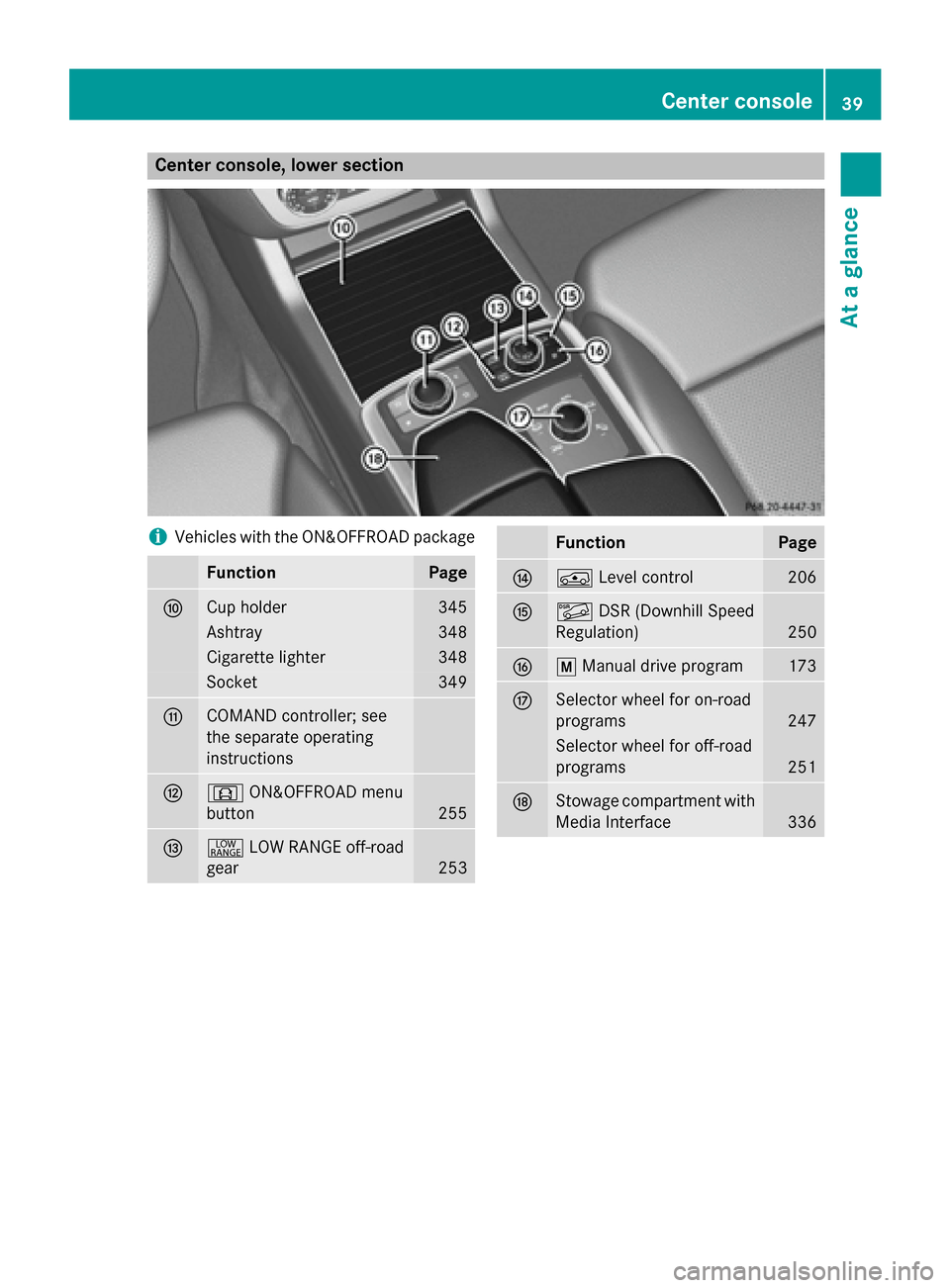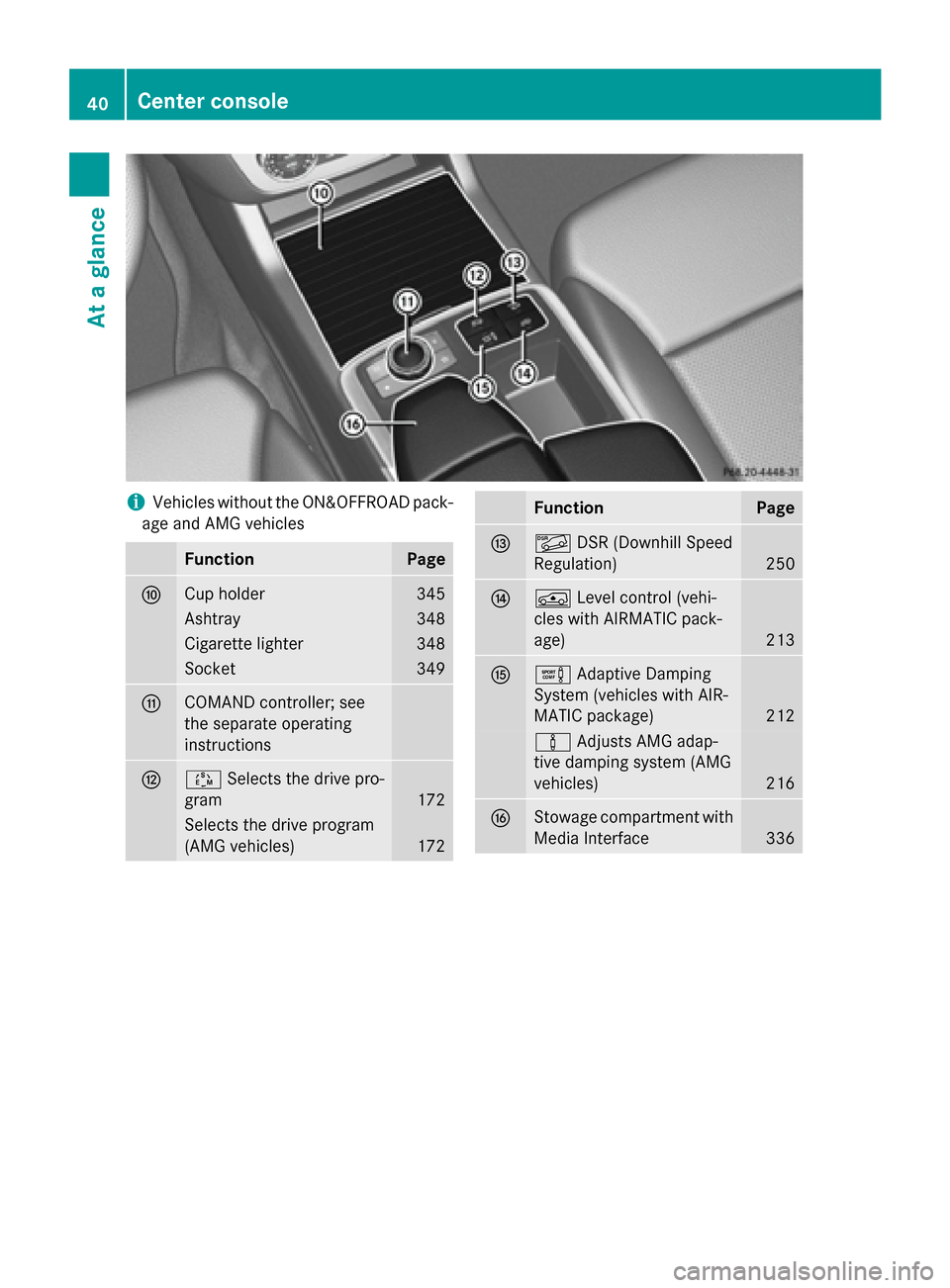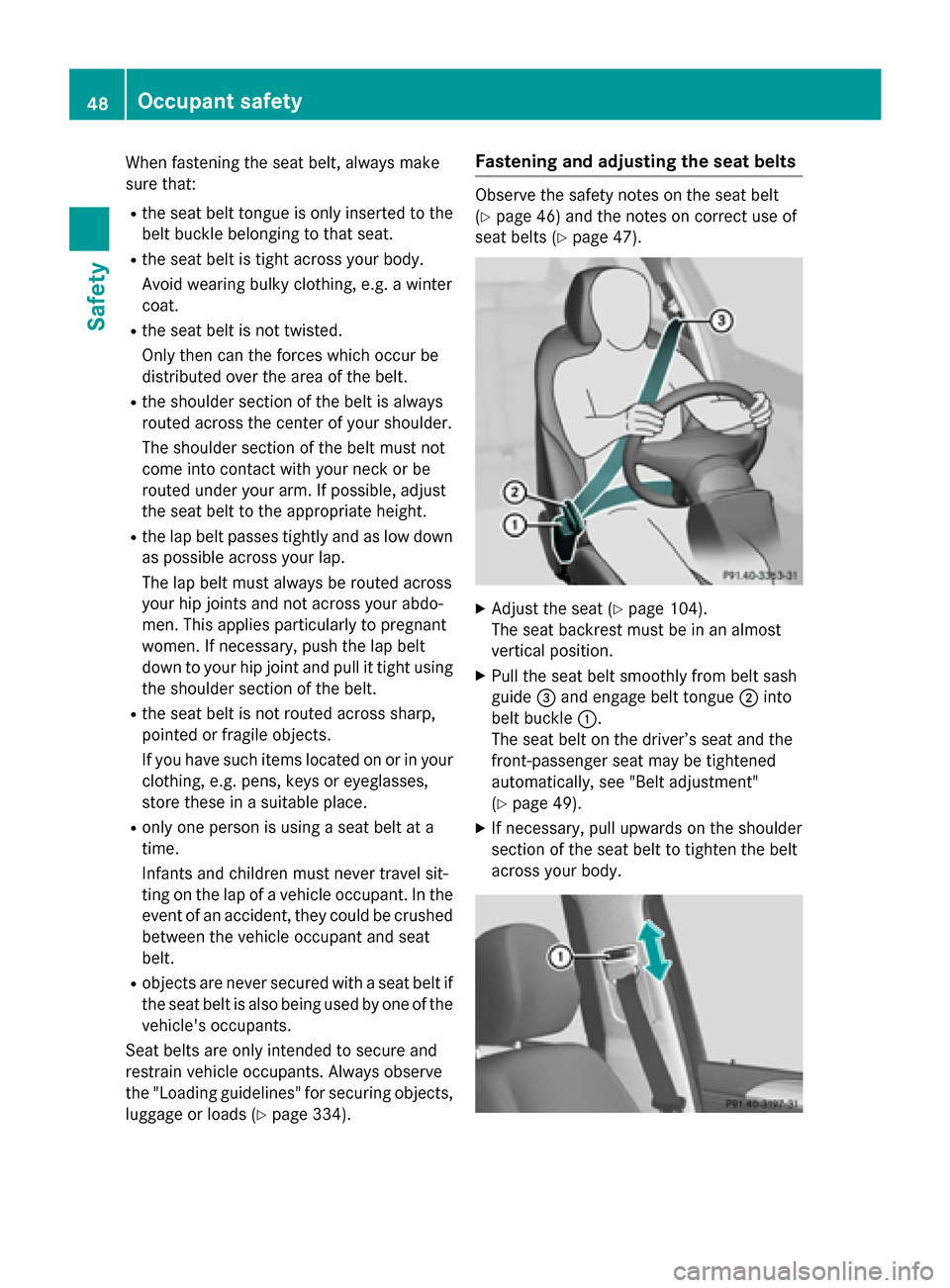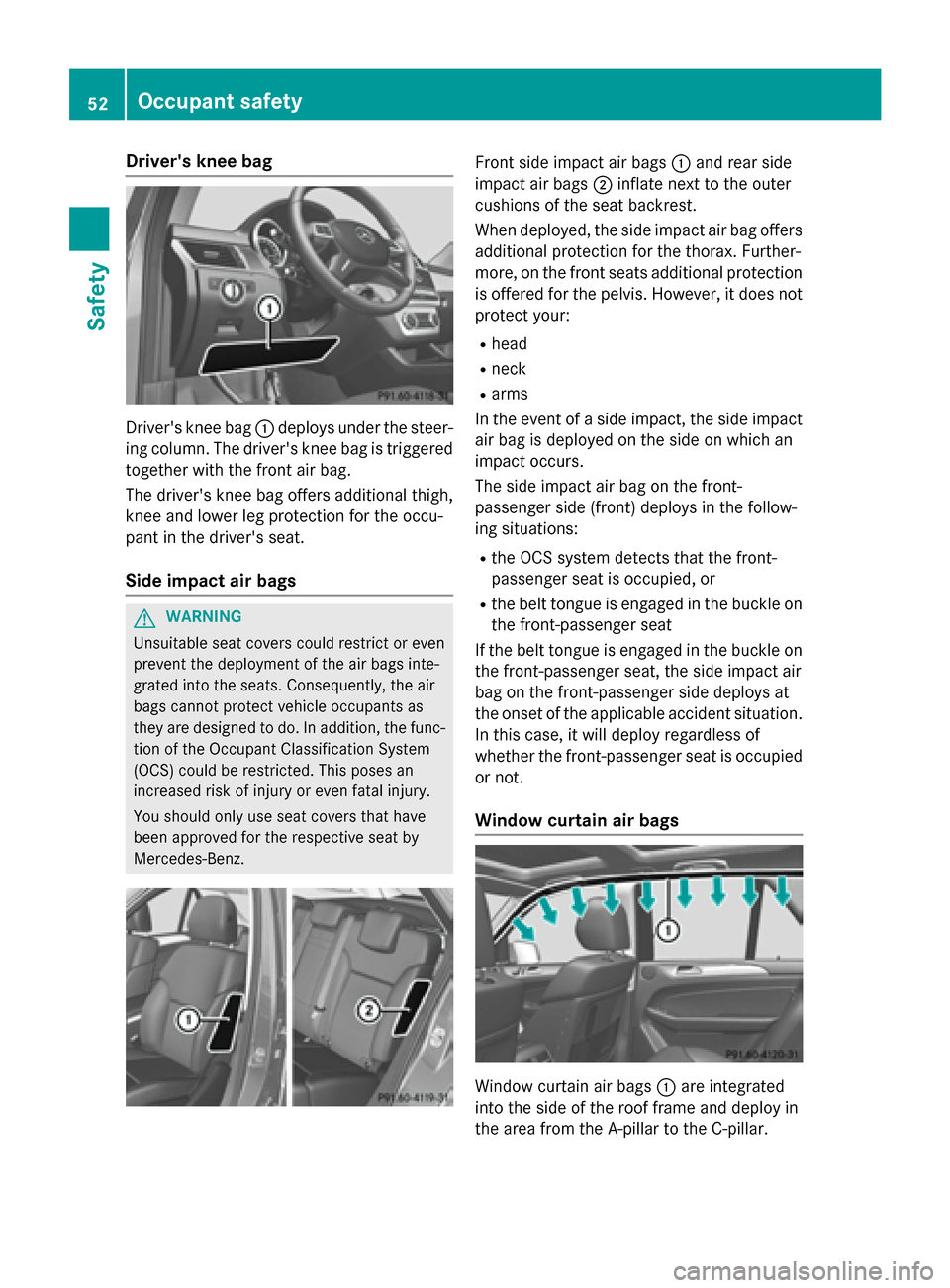2015 MERCEDES-BENZ M-Class drive
[x] Cancel search: drivePage 41 of 466

Center console, lower section
i
Vehicles with the ON&OFFROAD package Function Page
006E
Cup holder 345
Ashtray 348
Cigarette lighter 348
Socket 349
006F
COMAND controller; see
the separate operating
instructions
0070
0090
ON&OFFROAD menu
button 255
0071
002E
LOW RANGE off-road
gear 253 Function Page
0072
00C4
Level control 206
0073
00C6
DSR (Downhill Speed
Regulation) 250
0074
0063
Manual drive program 173
0075
Selector wheel for on-road
programs
247
Selector wheel for off-road
programs
251
0076
Stowage compartment with
Media Interface 336Center console
39At a glance
Page 42 of 466

i
Vehicles without the ON&OFFROAD pack-
age and AMG vehicles Function Page
006E
Cup holder 345
Ashtray 348
Cigarette lighter 348
Socket 349
006F
COMAND controller; see
the separate operating
instructions
0070
00C8
Selects the drive pro-
gram 172
Selects the drive program
(AMG vehicles)
172 Function Page
0071
00C6
DSR (Downhill Speed
Regulation) 250
0072
00C4
Level control (vehi-
cles with AIRMATIC pack-
age) 213
0073
0091
Adaptive Damping
System (vehicles with AIR-
MATIC package) 212
00CC
Adjusts AMG adap-
tive damping system (AMG
vehicles) 216
0074
Stowage compartment with
Media Interface 33640
Center consoleAt a glance
Page 46 of 466

Useful information
i This Operator's Manual describes all
models and all standard and optional equip- ment of your vehicle available at the time of
publication of the Operator's Manual.
Country-specific differences are possible.
Please note that your vehicle may not be
equipped with all features described. This
also applies to safety-related systems and
functions.
i Read the information on qualified special-
ist workshops (Y page 29). Panic alarm
X
To activate: press0033button 0043for at
least one second.
An alarm sounds and the exterior lighting
flashes.
X To deactivate: press0033button 0043
again.
or
X Insert the SmartKey into the ignition lock.
or X Press the KEYLESS-GO Start/Stop button.
The KEYLESS-GO key must be in the vehi-
cle. Occupant safety
Restraint system: introduction
The restraint system reduces the risk of occu-
pants hitting parts of the vehicle interior in the
event of an accident. Furthermore, the
restraint system may also reduce the forces
exerted on the vehicle occupants when an
accident occurs.
The restraint system includes:
R Seat belt system
R Air bags
R Child restraint system
R Child seat securing system
The components of the restraint system work
in conjunction with each other. They can only
offer the intended level of protection if all
vehicle occupants:
R are correctly wearing their seat belts.
(Y page 47)
R adjust their seat and head restraint prop-
erly (Y page 105).
The driver is also responsible for ensuring
that the steering wheel has been correctly
positioned. Observe the information relating
to the correct driver's seat position
(Y page 104).
Always ensure the air bag can inflate properly if deployed (Y page 50).
An air bag supplements a correctly fastened
seat belt and is an additional safety device
providing increased protection for vehicle
occupants in appropriate accident situations.
For example, if the protection already provi-
ded by a correctly fastened seat belt will suf-
fice, the air bags are not deployed. Further-
more, only the air bags that would increase
the degree of protection afforded to the vehi- cle occupants in the event of an accident are deployed. Seat belts and air bags generally do
not protect against objects penetrating the
vehicle from the outside.
Information on the restraint system operation can be found under "Triggering of belt ten-
sioners and air bags" (Y page 58).44
Occupant safetySafety
Page 50 of 466

When fastening the seat belt, always make
sure that:
R the seat belt tongue is only inserted to the
belt buckle belonging to that seat.
R the seat belt is tight across your body.
Avoid wearing bulky clothing, e.g. a winter
coat.
R the seat belt is not twisted.
Only then can the forces which occur be
distributed over the area of the belt.
R the shoulder section of the belt is always
routed across the center of your shoulder.
The shoulder section of the belt must not
come into contact with your neck or be
routed under your arm. If possible, adjust
the seat belt to the appropriate height.
R the lap belt passes tightly and as low down
as possible across your lap.
The lap belt must always be routed across
your hip joints and not across your abdo-
men. This applies particularly to pregnant
women. If necessary, push the lap belt
down to your hip joint and pull it tight using
the shoulder section of the belt.
R the seat belt is not routed across sharp,
pointed or fragile objects.
If you have such items located on or in your
clothing, e.g. pens, keys or eyeglasses,
store these in a suitable place.
R only one person is using a seat belt at a
time.
Infants and children must never travel sit-
ting on the lap of a vehicle occupant. In the
event of an accident, they could be crushed
between the vehicle occupant and seat
belt.
R objects are never secured with a seat belt if
the seat belt is also being used by one of the
vehicle's occupants.
Seat belts are only intended to secure and
restrain vehicle occupants. Always observe
the "Loading guidelines" for securing objects,
luggage or loads (Y page 334). Fastening and adjusting the seat belts Observe the safety notes on the seat belt
(Y
page 46) and the notes on correct use of
seat belts (Y page 47). X
Adjust the seat (Y page 104).
The seat backrest must be in an almost
vertical position.
X Pull the seat belt smoothly from belt sash
guide 0087and engage belt tongue 0044into
belt buckle 0043.
The seat belt on the driver’s seat and the
front-passenger seat may be tightened
automatically, see "Belt adjustment"
(Y page 49).
X If necessary, pull upwards on the shoulder
section of the seat belt to tighten the belt
across your body. 48
Occupant safetySafety
Page 51 of 466

The shoulder section of the seat belt must
always be routed across the center of the
shoulder. Adjust the belt sash guide if neces-
sary.
X To raise: slide the belt guide upwards.
The belt guide will engage in various posi-
tions.
X To lower: hold belt guide release 0043and
slide the belt guide downwards.
X Let go of belt guide release 0043in the
desired position and make sure that the
belt guide engages.
All seat belts except the driver's seat belt are equipped with a special seat belt retractor to
securely fasten child restraint systems in the
vehicle. Further information can be found
under "Special seat belt retractor"
(Y page 61).
Releasing seat belts !
Make sure that the seat belt is fully rolled
up. Otherwise, the seat belt or belt tongue
will be trapped in the door or in the seat
mechanism. This could damage the door,
the door trim panel and the seat belt. Dam-
aged seat belts can no longer fulfill their
protective function and must be replaced.
Visit a qualified specialist workshop. X
Press release button 0043, hold belt
tongue 0044and guide it back towards belt
outlet 0087.
Seat belt adjustment The seat-belt adjustment is an integral part of
the PRE-SAFE ®
convenience function. This
function adjusts the driver's and front-
passenger seat belt to the upper body of the
occupants.
The belt strap is tightened slightly when:
R the belt tongue is engaged in the buckle
and
R the ignition is switched on
The seat-belt adjustment will apply a certain
tightening force if any slack is detected
between the vehicle occupant and the seat
belt. Do not hold on to the seat belt tightly
while it is adjusting.
You can switch the seat-belt adjustment on
and off in the on-board computer
(Y page 280).
Belt warning for the driver and front
passenger The
0076 seat belt warning lamp in the instru-
ment cluster is a reminder that all occupants
must fasten their seat belts. It may light up
continuously or flash. In addition, there may
be a warning tone.
Regardless of whether the driver's and front- passenger seat belts have already been fas-
tened, the 0076seat belt warning lamp lights
up for six seconds each time the engine is
started. If, after six seconds, the driver or
front-passenger seat belt has not been fas-
tened and the doors are closed, the 0076seat
belt warning lamp lights up. As soon as the
driver's and front-passenger seat belts are
fastened or a front door is opened again, the
0076 seat belt warning lamp goes out.
If the driver's seat belt is not fastened after
the engine is started, an additional warning
tone will sound. This warning tone stops after Occupant safety
49Safety Z
Page 52 of 466

six seconds or when the driver's seat belt is
fastened.
If the vehicle's speed exceeds 15 mph
(25 km/h) once and the driver's and front-
passenger seat belts are not fastened, a
warning tone sounds. A warning tone also
sounds with increasing intensity for
60 seconds or until the driver or front
passenger have fastened their seat belts.
If the driver or front passenger unfasten their seat belts during the journey, the seat belt
warning is activated again.
i For more information on the
0076seat
belt warning lamp, see "Warning and indi-
cator lamps in the instrument cluster, seat
belts" (Y page 318). Air bags
Introduction The installation point of an air bag can be rec-
ognized by the AIR BAG symbol.
An air bag complements the correctly fas-
tened seat belt. It is no substitute for the seat
belt. The air bag provides additional protec-
tion in applicable accident situations.
Not all air bags are deployed in an accident.
The different air bag systems function inde-
pendently from one another (Y page 58).
However, no system available today can com- pletely eliminate injuries and fatalities.
It is also not possible to rule out a risk of injury
caused by an air bag due to the high speed at which the air bag must be deployed.
Important safety notes G
WARNING
If you do not sit in the correct seat position,
the air bag cannot protect as intended and
could even cause additional injury when
deployed. This poses an increased risk of
injury or even fatal injury. To avoid hazardous situations, always make
sure that all of the vehicle's occupants:
R have fastened their seat belts correctly,
including pregnant women
R are sitting correctly and maintain the great-
est possible distance to the air bags
R follow the following instructions
Always make sure that there are no objects
between the air bag and the vehicle's occu-
pants.
R Adjust the seats properly before beginning
your journey. Always make sure that the
seat is in an almost upright position. The
center of the head restraint must support
the head at about eye level.
R Move the driver's and front-passenger
seats as far back as possible. The driver's
seat position must allow the vehicle to be
driven safely.
R Only hold the steering wheel on the out-
side. This allows the air bag to be fully
deployed.
R Always lean against the backrest while driv-
ing. Do not lean forwards or lean against
the door or side window. You may other-
wise be in the deployment area of the air
bags.
R Always keep your feet in the footwell in
front of the seat. Do not put your feet on the
dashboard, for example. Your feet may oth- erwise be in the deployment area of the air
bag.
R For this reason, always secure persons less
than 5 ft (1.50 m) tall in suitable restraint
systems. Up to this height, the seat belt
cannot be worn correctly.
If a child is traveling in your vehicle, also
observe the following notes:
R Always secure children under 12 years of
age and less than 5 ft (1.50 m)in height in
suitable child restraint systems.
R Child restraint systems should be installed
on the rear seats. 50
Occupant safetySafety
Page 53 of 466

R
Only secure a child in a rearward-facing
child restraint system to the front-
passenger seat when the front-passenger
front air bag is disabled. If the PASSENGER
AIR BAG OFF indicator lamp is permanently
lit, the front-passenger front air bag is dis-
abled (Y page 45).
R Always observe the instructions and safety
notes on the "Occupant Classification Sys-
tem (OCS)" (Y page 53) and on "Children
in the vehicle" (Y page 61) in addition to
the child restraint system manufacturer's
installation instructions.
Objects in the vehicle interior may pre-
vent the air bag from functioning cor-
rectly. Before starting your journey and to
avoid risks resulting from the speed of the air bag as it deploys, make sure that:
R there are no people, animals or objects
between the vehicle occupants and an air
bag.
R there are no objects between the seat, door
and B-pillar.
R no hard objects, e.g. coat hangers, hang on
the grab handles or coat hooks.
R no accessories, such as cup holders, are
attached to the vehicle within the deploy-
ment area of an air bag, e.g. to doors, side windows, rear side trim or side walls.
R no heavy, sharp-edged or fragile objects
are in the pockets of your clothing. Store
such objects in a suitable place. G
WARNING
If you modify the air bag cover or affix objects
such as stickers to it, the air bag can no longer function correctly. There is an increased risk
of injury.
Never modify an air bag cover or affix objectsto it. G
WARNING
Sensors to control the air bags are located in the doors. Modifications or work not per-
formed correctly to the doors or door panel-
ing, as well as damaged doors, can lead to the function of the sensors being impaired. The air
bags might therefore not function properly
any more. Consequently, the air bags cannot
protect vehicle occupants as they are
designed to do. There is an increased risk of
injury.
Never modify the doors or parts of the doors.
Always have work on the doors or door pan-
eling carried out at a qualified specialist work- shop.
Front air bags Driver's air bag
0043inflates in front of the
steering wheel; front-passenger air bag 0044
inflates in front of and above the glove box.
When deployed, the front air bags offer addi-
tional head and thorax protection on the front
seats.
The PASSENGER AIR BAG OFF indicator lamp shows you the status of the front-passenger
front air bag (Y page 45).
Front-passenger air bag 0044is only deployed
if:
R the Occupant Classification System (OCS)
recognizes that the front-passenger seat is
occupied (Y page 53)
R the PASSENGER AIR BAG OFF indicator
lamp is not lit (Y page 53)
R the restraint system control unit predicts a
high accident severity Occupant safety
51Safety Z
Page 54 of 466

Driver's knee bag
Driver's knee bag
0043deploys under the steer-
ing column. The driver's knee bag is triggered
together with the front air bag.
The driver's knee bag offers additional thigh,
knee and lower leg protection for the occu-
pant in the driver's seat.
Side impact air bags G
WARNING
Unsuitable seat covers could restrict or even
prevent the deployment of the air bags inte-
grated into the seats. Consequently, the air
bags cannot protect vehicle occupants as
they are designed to do. In addition, the func- tion of the Occupant Classification System
(OCS) could be restricted. This poses an
increased risk of injury or even fatal injury.
You should only use seat covers that have
been approved for the respective seat by
Mercedes-Benz. Front side impact air bags
0043and rear side
impact air bags 0044inflate next to the outer
cushions of the seat backrest.
When deployed, the side impact air bag offers additional protection for the thorax. Further-
more, on the front seats additional protection
is offered for the pelvis. However, it does not protect your:
R head
R neck
R arms
In the event of a side impact, the side impact
air bag is deployed on the side on which an
impact occurs.
The side impact air bag on the front-
passenger side (front) deploys in the follow-
ing situations:
R the OCS system detects that the front-
passenger seat is occupied, or
R the belt tongue is engaged in the buckle on
the front-passenger seat
If the belt tongue is engaged in the buckle on the front-passenger seat, the side impact air
bag on the front-passenger side deploys at
the onset of the applicable accident situation. In this case, it will deploy regardless of
whether the front-passenger seat is occupied
or not.
Window curtain air bags Window curtain air bags
0043are integrated
into the side of the roof frame and deploy in
the area from the A-pillar to the C-pillar. 52
Occupant safetySafety